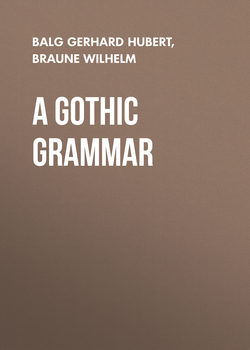Читать книгу A Gothic Grammar - Braune Wilhelm - Страница 2
FONOLOGY
CHAP. I. THE ALFABET
Оглавление§ 1. The monuments of the Gothic language ar handed down to us in a peculiar alfabet which, according to Greek ecclesiastic writers, was invented by Wulfila (s. § 221). The Gothic alfabet, however, is not entirely a new creation, but Wulfila based it on the Greek alfabet which he accomodated to the Gothic sounds, increasing it by several signs from the Latin alfabet, and, in a few cases, availing himself of the familiar runic alfabet. Of the Greek alfabet he also retaind the order and numerical value. The Gothic alfabet is now sufficiently represented in Roman letters. In the following we giv in the first line the original Gothic characters, in the second their numerical values, in the third the transliteration of the Gothic characters by Roman letters, which latter we shall uze exclusivly in this book.
Note 1. Of these signs one (i, 10) is represented by two forms. The i without dots occurs oftener, the i with dots stands at the beginning of a word, and in the midl of a word after a vowel, to show that it forms a syllabl for itself and does not form a difthong with the preceding vowel; e. g., fraïtiþ (= fra-itiþ). In transliteration i is employd thruout.
Note 2. Two characters, the Greek episema 'koppa' (90) and 'sampi' (900), hav no fonetic values, but serv only as numerals. When the symbols denote numerals, they ar markt by a horizontal stroke abuv them, or by dots before and after them: ib or ·ib· = 12.
Note 3. The transliteration of the Gothic symbols is not alike in all cases. Most editors hav hitherto uzed v for w (§ 39, n. 1); for the singl symbols q (§ 39, n. 1) and ƕ (§ 63) we find kv or qu and hv or w, respectivly; for þ, which is borrowd from the Norse-A. – S. alfabet, also th occurs (§ 70, n. 1).
Note 4. The Gothic monuments show but few abbreviations; the holy names, guþ, frauja, iêsus, Χristus, ar always abbreviated. Abbreviations ar denoted by a stroke abuv the word, but in our texts the abbreviated words ar uzually printed in ful; as, gþ = guþ, fa, fins = frauja, fraujins. – For more on this point, s. Gabelentz-Loebe's grammar, p. 19 et seq.
Note 5. The Goths alredy had the Germanic runic letters before Wulfila. The names of these letters wer uzed also for the new characters. The names of the Gothic symbols, together with a few Gothic words and alfabets, ar preservd in a Salzburg-Vienna manuscript of the 9th century: W. Grimm, 'Wiener Jahrbücher der Litteratur 43', p. 4 et seq. Massmann, zs. fda. 1, p. 296 et seq. – The form of the names, however, is very corrupt. As to this, cp. A. Kirchhoff, 'Das Gotische Runenalphabet', 2nd edit., Berlin 1854; J. Zacher, 'Das Gotische Alphabet Vulfilas und das Runenalphabet', Leipzig 1855. – Of special importance is Wimmer's treatis on Wulfila's alfabet, as 'Appendix I' to his book: 'Die Runenschrift', Berlin 1887, pp. 259-274.
§ 2. Of the 27 characters two hav only numerical values, (§ 1, n. 2), a third, the χ, is retaind only in Greek foren words, especially in the name 'Christus', and denotes no Gothic sound. Hense there remain the following 24 characters whose fonetic values ar to be determind:
(a) Consonants:
p b f m w | t d þ s z n l r | k q g h ƕ j.
(b) Vowels:
a e i o u.
(c) Difthongs:
ei iu ai au.
In determining the fonetic values of these characters we ar guided by the following means: (1) The Gothic alfabet is based on the Greek alfabet; hense, the pronunciation of the Greek letters to be determind for the 4th century, must also be regarded as that of the Gothic letters so long as there is no proof to the contrary. (2) The rendition of the numerous Greek foren words and proper nouns by Wulfila. (3) The transliteration of the Gothic proper nouns in Latin documents and by Latin authors of the 4th-8th centuries. (4) The testimony of the cognate Germanic languages. (5) Fonetic changes and grammatical fenomena in the Gothic language itself permit us to draw conclusions about the nature of the sounds.
Note 1. Concerning the pronunciation of the Gothic letters, cp. Weingärtner, 'Die Aussprache des Gotischen zur Zeit des Ulfilas', Leipzig 1858; Fr. Dietrich, 'Ueber die Aussprache des Gotischen während der Zeit seines Bestehens', Marburg 1862; about the consonants, Paul, 'Zur Lautverschiebung', Beitr. 1, p. 147 et seq.
Note 2. An old testimony for the Gothic pronunciation in the Salzburg-Vienna MS.:
ubi dicit. genuit .j. ponitur ubi gabriel .g. ponunt et alia his sim̅ ubi aspiratione. ut dicitur gah libeda jah libaida diptongon ai pro e longa p ch q ponunt. – Cp. § 1, n. 5, and, for explanation, especially Kirchhoff, p. 20 et seq.
